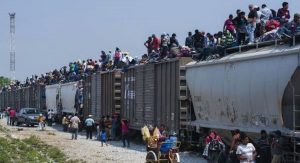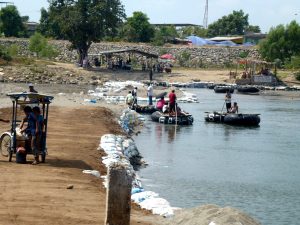IMMIGRATION POLICY – SOME UNSOLICITED ADVICE FOR AMERICA
America has historically been the dream destination for the aspiring genius, the creative entrepreneur and the huddled masses. America is scoring an own goal and quickly and unnecessarily losing its luster as a beacon of hope and opportunity.

Refugees braving winter weather to leave US and enter Canada in early 2017. They are welcomed by police but must meet refugee test to remain.
President Trump uncharacteristically suggested in his speech to Congress that the Canadian immigration system may have something to teach America. With that encouragement, I will offer a few ideas.Is immigration good for America?
1. Immigration can be a source of additional economic growth if immigrants represent youth, skills, energy and consumption. In other words, if they are encouraged to be full participants in the economy.
2. America is an open society that can attract and benefit from the creative genius that exists globally.
But…..
History, an undisciplined system of governance and unrealistic expectations of personal success result in demographics (within the American population) that do not match the job market. An inappropriate immigration policy – if the term policy is the correct term for the current situation – arguably does not produce the results that would make immigration a success in America.
Suggested immigration policies and principles for America
1. How many immigrants?
Legal immigration to America has been at a level of 1,000,000 per year for some time. More than 50% are people already in America who simply change their legal status. This represents 0.3% of US population annually. In comparison immigration to Canada has represented 0.7% per year and is scheduled to increase to 0.9%. Australia is similar to Canada. The appropriate level of immigration to America should be not less than 2,000,000 per year and better outcomes if 2,500,000.
2. Categories of immigrants.
a. Family unification
The US immigration policy or outcome is heavily skewed to family re-unification at 60-65% of immigrants compared to 25% In Canada. Family unification is itself an appropriate category but these immigrants are not selected based on merit if that implies skills or regional mobility. The dominance of this category squeezes out the other categories – given a limited overall total – categories that would make immigration feel more successful.
Super Visa
Canada initiated an interesting innovation recently to address the desire of families to sponsor parents and grandparents. Given the realities of communication, social media and low cost transportation – Canada has initiated a 10 year “super-visa” for parents and grandparents. They can come and go freely, support (their Canadian) families through child care but cannot accept a job, are required to have their expenses covered by family and the visa does not lead to permanence.
b. Refugees
The US admits 60,000 refugees per year, 6% of the immigrant flow and 0.018% of its population. Canada normally admits 25,000 or 10% of immigration, and 0.070% of population. In 2016 Canada admitted 60,000 refugees and current plans are for 40,000 per year. The Canadian program of “private sponsorship” of refugees has been a critical factor in the ability of refugees to become successful and to create the political support for refugee immigration.
c. Diversity Lottery
This is a unique creature of America where a substantial number of immigration slots are distributed by lottery. The original objectives may be commendable but with the limited size of the legal immigration program this random selection is unlikely to contribute to success. Canada does not have a similar program.
d. Economic migrants
These are immigrants selected on the basis of age and skills that are in demand. The nature and rules of the current US program – popularly referred to as H1b visas – results in a domination of this category by IT specialists employed by companies, predominantly from India, who have figured out how to game the system. The H1-b visas are actually considered as temporary workers with transition to permanent insecure. The number of arrivals is about 85,000 per year.
The permanent economic category should really be the largest and dominant category in any immigration program – implying arrivals of more than 1,000,000 immigrants per year. This category represents 65% of immigrants to Canada. An important difference is that economic migrants into Canada are expected to remain and become citizens – the pathway to permanence in the US is much more difficult.
e. Low-skilled workers
This category as an official immigrant category does not really exist in either Canada or the US but is supplied in each country in very different ways. In America it is quite usual to hear the expression that immigrants – often really referring to undocumented migrants “do the dirty, difficult and low-prestige jobs that Americans no longer want to do”. There is a “Catch-22” quality to this argument. America, through bad policy, has permitted or at least facilitated the existence of the incredibly large pool of undocumented migrants who fill these jobs. Their precarious legal existence does not allow them to climb the economic and skills ladder. Second, the risk and difficulty of entry across the southern border ensure that only the desperate and economically disadvantaged will submit to these conditions. American policy ensures that the undocumented group will represent less skill and therefore be willing to do menial work at subpar wages and conditions. America needs to either create conditions where it’s own citizens will fill these jobs or create a program where this category of person can work legally.
The Canadian approach to less skilled labor
Canada fills this void in several ways. The family unification program and the refugee inflow often represent persons with less skill or persons who require a period of adaptation. Canada also has programs like the “nanny” program that legally increase the supply of service workers. However, these persons all have legal status, full access to services and the opportunity to climb the economic ladder.
The role of Temporary Worker programs
Canada has a number of programs that bring economically active workers to Canada on a temporary basis. When well-managed, these programs fill the gaps in a more logical way than the undocumented in America.
Seasonal Agricultural workers
Canada provides seasonal permits for 42,000 workers per year from the Caribbean, Mexico and Central America. (Recent US visas for temporary agricultural workers have been in the range of 140,000 per year). A similar program in America would be half a million and given climate might be twice as large. Workers under this program in both Canada and the USA are protected as to wages and conditions. They represent an assured supply for employers and most important this program maintains family structures and provides income to poor communities. America does have limited seasonal worker access but inadequate relative to the need.
Temporary workers related to projects, specific industries or as response to periodic skills shortages
Canada typically allows more than 300,000 such workers to be in the country, generally on permits up to two years. They have full legal status and protection. In many cases they are permitted to bring family. Many of these temporary workers transition to permanent status and citizenship later. This is a good recruitment tool for Canada (for permanent immigrants) since these are known people and therefore low risk. The categories are different between the two countries but excluding the H1-b visas the total of temporary entries is basically equal between the two countries – yet Canada Is only one-tenth the size in terms of population.
Experience Canada
A successful program that allows young people from around the world the opportunity to live and work anywhere in Canada for a period of time such as one year. Typically these are educated, capable and energetic youth who represent a great pool of employees for service industries such as seasonal resorts. Many of these young people become attracted and attached to Canada and will eventually transition to permanent resident status under some other program.
If the USA had a similar package of policies one can draw the following conclusions.
- If immigration levels were 2,000,000 to 2,500,000 per year instead of the current 1,000,000 that would represent an additional 10-15 million landed immigrants over the last decade – a number that matches or exceeds the entire current undocumented population.
- This scale of program would permit a program more oriented to skills and economic requirements.
- If the above was matched with temporary or seasonal legal work access, a policy comparative to Canada would result in possibly 4 million legal workers matched to demand.
International Students
Both Canada and the USA have important and overall successful policies of attracting and educating foreign students. (Depending on how you count approximately 13% of students in Canada and 10-12% in the USA represent foreign students in the post-secondary population.) Both countries charge higher fees to these students and use their presence as a source of income for Universities and for the economy. The path to permanent residence has been challenging in both countries but Canada has recently recognized the folly of educating and acculturating selected young people and then asking them to leave. Accordingly there are now more opportunities for graduating foreign students to remain in Canada. The pathway to permanence in the USA remains more difficult. A recent innovation in Canada is to allow foreign students to work while they are in Canada to contribute to the financing of their education. A combination of policies such as the opportunity to work, generally lower tuition fees in Canada and the recent geopolitical environment have increased the attractiveness of Canadian Universities to foreign students. This is being reflected in increased applications.
Citizenship
In the USA an estimated 40% of foreign born are US citizens. In Canada it is expected that 85% of landed immigrants will become Canadian citizens. The equivalent in Europe is 20%. Attachment to a nation is a profoundly important aspect of successful immigration. The antipathy in the US to the granting of citizenship contributes to a failed policy.
Comments re Europe
The European continent has a long history as a source of emigrants rather than a destination. Post WWII and post-Colonial developments have changed the situation in Europe. This has been compounded by demographic developments and the creation of the EU. Europe struggles with the idea of immigration in the Canadian sense. However, the structure of the EU and the policy of mobility across 28 borders allows a natural sorting out of employment opportunities and labor shortages – without the need to change or acquire passports. This reality is not without issues but the policy of mobility has contributed to an overall successful Europe. The refugee surge starting in August of 2015 is adding new complications.
Conclusions:
1. America would benefit from an immigration program that allows for legal entry of the people it needs in any event. Such a program could create space for some of the current undocumented and result in a more moral basis for border and entry control.
2. America would do well with a properly designed and managed temporary work program. Many of the current undocumented come from places that are not inherently dangerous and could support their families in their home countries and maintain acceptable contact – assuming seasonal or time-limited visas with travel freedom.
3. President Trump described the Canadian system as merit-based. Another term I like to use is “Likely to Succeed”. This implies success at various levels in the workplace and socially – but immigrants who are contributing and allowed and encouraged to invest in the next generation.
4. Citizenship and attachment to the society is critical to a successful immigration program.
5. Another unique feature in Canada is the PNP or Provincial Nominee Program. Under the Canadian Constitution immigration is a shared responsibility. Agreements between the Federal Government and individual provinces allow for selection of immigrants by Provinces based on their priorities. This ensures a greater local “touch” and contributes both to immigrant success and political support. America like Canada has vast regional differences and would benefit from an immigration system that allowed some degree of regional initiative.
- The Mexican -US border is a dangerous place with or without a wall.
As a Canadian who is reasonably informed about our system – I can offer plenty of criticisms of the Canadian system – until I remember (with very limited exceptions like New Zealand and Australia) – that all of the other systems are much worse. As Canadians, we sometimes quietly remind ourselves that the dreadful US approach to immigration is a kind of blessing. The global reality is that most potential immigrants would choose America – until they are dissuaded by the reality and the rhetoric.
Nevertheless, the inhumane treatment of millions of migrants who are permitted to remain because they are useful but then treated in violation of many conventions – not to mention Christian values and principles – is a self-inflicted wound on the promise of America.
The American paranoia about security and guns is a subject for another essay – but a comment about the control of the borders.
There are genuine and valid reasons to manage the border but a militarized approach will not assure success and is not a substitute for good policy.
1. Start with an immigration policy that reflects reality. The preceding comments speak to policy that balances economic and labor needs with the reality of the geopolitical neighborhood.
2. The USA would do well to focus on its neighborhood down to Panama to create stable and successful political and economic nations that can hold their people and share in a larger prosperity. Supporting dictators will not accomplish that!
3. Assuming a more successful and democratic Central America – the limited number of political fugitives can be managed regionally within established norms.
A combination of the above policies would create conditions where border management would become both possible and acceptable – but there is plenty of reality between that vision and today.
We all wish America well and trust they will find their way to a more enlightened policy regarding the movement and welcome of people.
I have written extensively on migration and refugee issues over the years and if the reader is interested in additional views or facts on the subject they are directed to the following articles on my website.
- Making Sense of Migration
Presented to the Trilateral Commission in Mexico City in 2010 plus the UN Global Migration Conference. It speaks to the larger issues of migration plus a more detailed explanation of the Manitoba Provincial Nominee Program including charts. - Blog #24 – The Changing Dynamics of Refugee Movements
- Blog #17 – The Refugee Dilemma
Deeper analysis as to why the refugee problem has increased so dramatically and why it is unlikely to go away.









